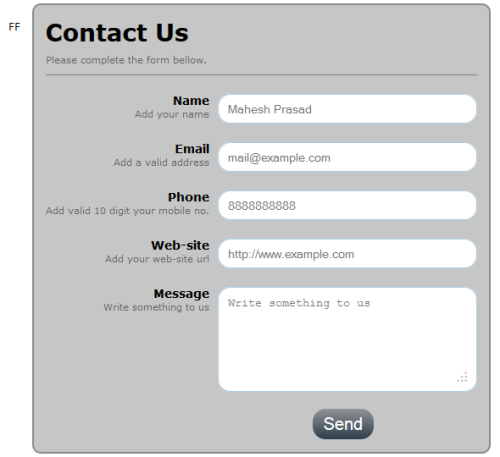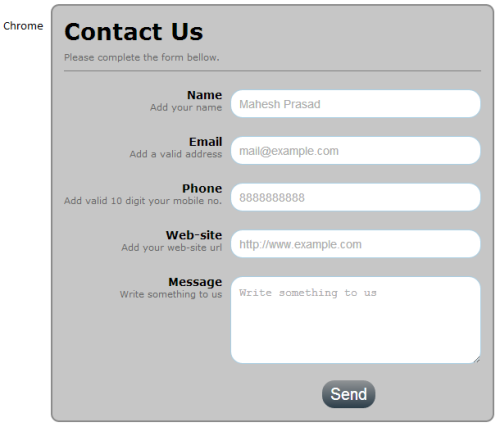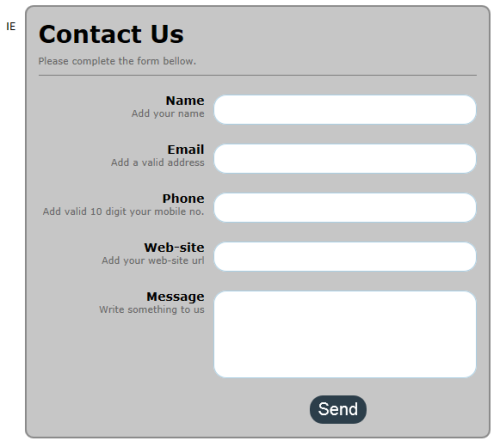Pure CSS and DIV based Contact Us form design
Here is how you can design Pure CSS and DIV based Contact Us form design.
I have used simple design, it is not much complited to understand.
Here is how it look like:
1.)FF
2.)Chrome
3.) IE
Full HTML with CSS source code:
Modify border and colors as you like.
<!DOCTYPE html>
<html>
<head>
<title>Contact Us</title>
<meta http-equiv="Content-Type" content="text/html; charset=UTF-8">
<style>
body{
font-family:Verdana, Arial, Helvetica, sans-serif;
font-size:14px;
}
p, h1, form, button{border:0; margin:0; padding:0;}
.spacer{clear:both; height:1px;}
/* ----------- My Form ----------- */
.myform{
margin:0 auto;
width:509px;
padding:14px;
}
/* ----------- form-wrapper ----------- */
#form-wrapper{
background: none repeat scroll 0 0 #C6C6C6;
border: 2px solid #8B8B8B;
border-radius: 10px;
-moz-border-radius: 10px;
-op-border-radius: 10px;
-webkit-border-radius: 10px;
}
#form-wrapper h1 {
font-weight:bold;
margin-bottom:8px;
}
#form-wrapper p{
font-size:11px;
color:#666666;
margin-bottom:20px;
border-bottom:solid 1px #7E7E7E;
padding-bottom:10px;
}
#form-wrapper label{
display:block;
font-weight:bold;
text-align:right;
width:193px;
float:left;
}
#form-wrapper .small{
color:#666666;
display:block;
font-size:11px;
font-weight:normal;
text-align:right;
width:193px;
}
#form-wrapper input,#form-wrapper textarea{
float:left;
border:solid 1px #aacfe4;
width:284px;
margin:2px 0 20px 10px;
border-radius: 15px;
-moz-border-radius: 15px;
-op-border-radius: 15px;
-webkit-border-radius: 15px;
font-size: 14px;
}
#form-wrapper input{
height: 25px;
padding: 4px 10px;
}
#form-wrapper textarea{
padding: 10px 10px;
overflow: auto;
}
/* ----------- Form Button ----------- */
#form-wrapper button {
background: #2c3e4a;
background: -webkit-gradient(linear, left top, left bottom, from(#919496), to(#2c3e4a));
background: -webkit-linear-gradient(top, #919496, #2c3e4a);
background: -moz-linear-gradient(top, #919496, #2c3e4a);
background: -ms-linear-gradient(top, #919496, #2c3e4a);
background: -o-linear-gradient(top, #919496, #2c3e4a);
padding: 5px 10px;
-webkit-border-radius: 15px;
-moz-border-radius: 15px;
border-radius: 15px;
margin-left: 315px;
color: white;
font-size: 20px;
text-decoration: none;
vertical-align: middle;
}
#form-wrapper button:hover {
background: #3d4b54;
color: #ccc;
}
</style>
</head>
<body>
<div id="form-wrapper" class="myform">
<form id="form" name="form" method="post" action="index.html">
<h1>Contact Us</h1>
<p>Please complete the form bellow.</p>
<label for="name">Name
<span class="small">Add your name</span>
</label>
<input type="text" name="name" placeholder="Mahesh Prasad" id="name" />
<label for="email">Email
<span class="small">Add a valid address</span>
</label>
<input type="text" name="email" placeholder="mail@example.com" id="email" />
<label for="phone">Phone
<span class="small">Add valid 10 digit your mobile no.</span>
</label>
<input type="text" name="phone" placeholder="8888888888" id="phone" />
<label for="web">Web-site
<span class="small">Add your web-site url</span>
</label>
<input id="web" type="text" placeholder="http://www.example.com" name="web" id="web">
<label for="message">Message
<span class="small">Write something to us</span>
</label>
<textarea placeholder="Write something to us" name="message" id="message" rows="5"></textarea>
<button type="submit">Send</button>
<div class="spacer"></div>
</form>
</div>
</body>
</html>








Recent Comments